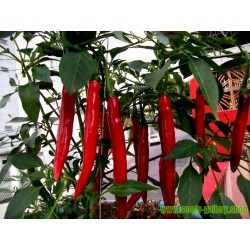







Long Slim Red Cayenne is one of the best known hot chili peppers, it is a good long hot chilli that always performs well and dries nicely.
Producing an abundance of very wrinkled fruits that grow 12 to 15cm (5 to 6in) long, the fruits have thin flesh and are used fresh in hot sauces or dried and ground for cayenne pepper. At a heat level of around 30,000 to 50,000 SHU, they are one of the best peppers for seasoning pickles and salsa. Good for deep freezing and perfect for adding a kick to a Bloody Mary or to vodka.
Long Slim Red Cayenne is a very productive plant, it is upright-growing and reaches about 60cm in height. The plants are covered with long, thin peppers which mature from emerald green to a scarlet red in approximately 70 days.
This very attractive plants also make quite a spectacle when grown as a conservatory or patio plant.
According to one anonymous writer, this variety was first documented in 1493 by Christopher Columbus and that one of his passengers, a man named de Cuneo, described how Native Americans ate peppers like one would eat an apple. Cayenne peppers are used threaded onto a string as attractive 'Ristra' craft decorations.
Storage of Seeds:
Store seeds away from children, sealed in their packaging in a cool, dry, dark place, or in a fridge. Never store them in a freezer as the sudden temperature drop is likely to kill them. Don't leave the seeds in direct sunlight as the heat generated may kill them.
Sowing: Sow from mid February to mid June
The temperature, moisture, and air circulation all play a role in growing plants from seeds. Too little heat, too much moisture, and lack of air circulation will cause poor results. Do not use jiffy peat pots, plugs, or potting soil as the soil becomes too dry or too wet, which can lead to low germination, disease and fungus.
Fill small cells or trays with a good sterile seed compost and sow the seeds on the surface. “Just cover” with a fine sprinkling (3mm) of soil or vermiculite.
Keep the compost moist - don't let the top of the compost dry out (a common cause of germination failure) If you wish, spray the surface with a dilute copper-based fungicide.
Cover the pot or tray with plastic film or place in a heated propagator, south facing window or a warm greenhouse.
The ideal temperature is around 18 to 20°C (65 to 72°F)
Transplanting:
When the seedlings have produced their first pair of true leaves they can be potted on into individual 7 to 10cm (3 to 4in) pots. Use good quality potting compost and mix in some organic slow release fertiliser. Pot the chilli on again before it becomes root-bound.
Water the seedlings regularly, but don't let them become waterlogged as this encourages rot. Don't let them dry out as they rarely recover at this stage. Water the soil, not the foliage. Once the plants have established, it is better to water heavy and infrequently, allow the top inch or so to dry out in between watering.
Seedlings should be grown in good light, but should not be exposed to direct sunlight from late spring to early autumn. Weaker sunlight from autumn to spring is unlikely to do them harm. Once seedlings have put on some growth they need lots of light. Growing them under a grow-light produces excellent stocky plants, as will a warm sunny windowsill. Adult chilli plants need lots of light. However, more than 4 hours or so in hot direct sunlight will dry them out quickly.
Acclimatise to outdoor conditions for 2 to 3 weeks before they are moved permanently outside. Plant them into rich moist soil. Flower do not form and fruit will not set if the temperature is much below 17°C (62°F) for most of the day, so wait until June/July for best results with outdoor planting.
Fertilising:
After the first flowers appear, feed every one or two weeks with a half-strength liquid tomato feed. You could also add Seaweed extract to the water once a week.
Pollinating Flowers: (optional)
Chilli plants are self fertile and will generally pollinate themselves. However, if you want to give them a helping hand to ensure that lots of fruit are set indoors, use a cotton wool bud to gently sweep the inside of the flowers, spreading the pollen as you go. The flower's petals will drop off as the green middle part of the flower starts to swell slightly. This is the chilli pepper beginning to grow.
Harvesting: Harvest in 90 to 110 days
Chillies will take a few weeks to develop and a further couple weeks to turn from green to red. Harvest any time after they are fully developed. Use scissors to snip the fruits so you don't damage the plant.
Storage:
After being roasted and peeled, Poblanos can be preserved by either canning or freezing. Storing poblanos in airtight containers will suffice for several months.
WARNING:
Be careful handling chilli seeds as they can cause a painful burning sensation: Avoid contact with the eyes or any sensitive skin before washing your hands thoroughly.
Origin:
Chiles originated in South America, where they have been under cultivation since prehistoric times. The seed's long viability facilitated the rapid spread of the plant throughout the tropics and sub-tropics by the Spanish and Portuguese, the spice becoming as popular there as vine pepper. Chiles were long known as 'Indian' pepper - meaning 'of the New World' rather than 'of India'.
The Cayenne is known to be Pre-Columbian in origin. It is said to be named after the Cayenne River in French Guyana. First offered in the seed trade by Joseph Breck & Son in 1883
Data sheet

 Reviews (0)
Reviews (0)